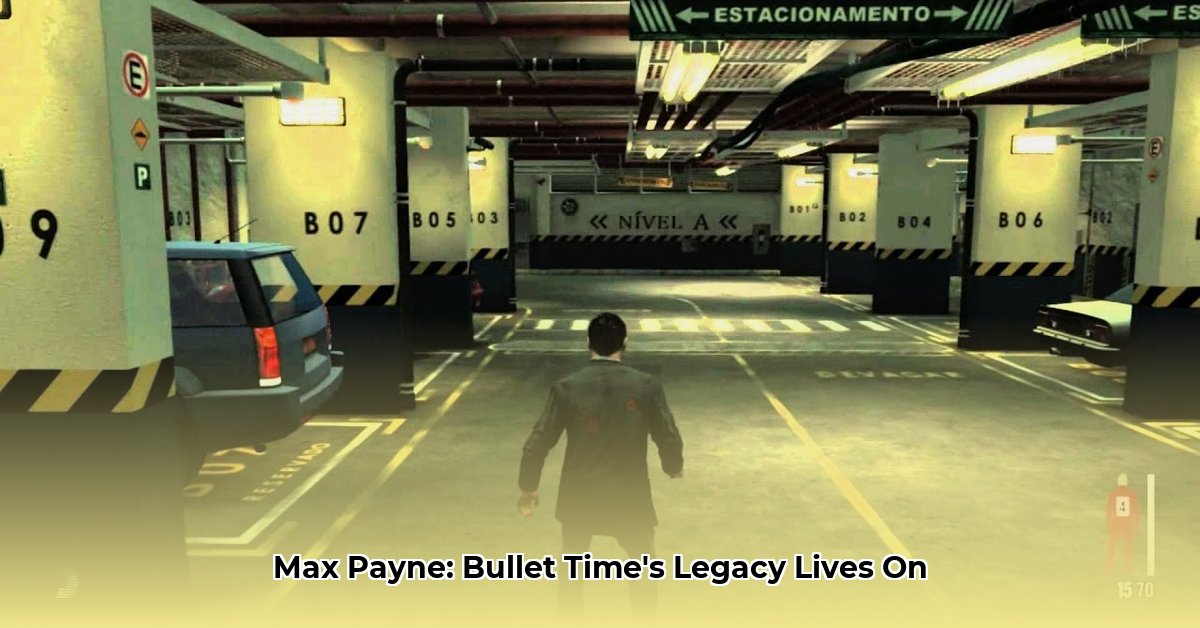
Let's journey back to the early 2000s, a time of dial-up internet and questionable fashion choices. Amidst this era emerged a game that irrevocably altered the third-person shooter landscape: Max Payne. This wasn't simply another run-and-gun; it was a cinematic experience, a dark ballet of violence punctuated by the revolutionary "bullet time" mechanic. But its impact extended far beyond a single, innovative feature. It was a perfect marriage of groundbreaking gameplay and a compelling, noir-infused narrative that resonated deeply with players.
Beyond Slow-Mo: A Deeper Dive into Max Payne's Mechanics
Max Payne's influence transcended its flashy bullet time feature. The innovative cover system, now a staple of the genre, was seamlessly integrated, transforming combat into a tactical dance of peek-and-shoot maneuvers. The game's physics engine, surprisingly advanced for its time, added a layer of visceral realism. Every gunshot, each recoil, every impact – all felt weighty and impactful, contributing to an immersive experience rarely seen before. "The sense of physicality, the weight of the weapons – that's something people still talk about to this day," notes veteran game journalist, Chris Kohler.
The Sequels: Could Lightning Strike Twice?
The subsequent Max Payne installments attempted to recapture the original's magic, but opinions on their success remain divided. While retaining the stylish action and bullet time, many felt the narrative failed to match the emotional resonance of the original. Others appreciated the expansion of the world and the enhancements made to some aspects of gameplay. However, did any sequel truly replicate the impact of its predecessor? That remains a question for each player to answer individually. A critical analysis of the sequels necessitates comparing their core elements to those of the original, and evaluating whether they improved upon the existing framework or altered it beyond recognition. Did these changes enhance the experience or dilute it?
A Lasting Influence: Max Payne's Impact on Gaming
Max Payne's influence on the gaming industry is undeniable. It fundamentally reshaped the third-person shooter genre, inspiring countless imitators that borrowed its bullet time, cover system, and dark, atmospheric style. Even today, its legacy is visible in modern shooters, a testament to its enduring design. "It wasn't just innovative; it set a new standard for cinematic action games – a standard that's still felt today," says Dr. Anya Petrova, Professor of Game Studies at the University of California, Berkeley.
The Future: Remakes, Reboots, and Beyond
What lies ahead for Max Payne? Remakes or remasters are certainly plausible, offering a chance for new audiences to experience the original's brilliance with modern visuals. A new entry in the franchise isn't impossible either, but careful consideration would be crucial to ensuring narrative coherence and stylistic consistency. "Imagine, a VR version? It might offer a truly immersive experience," suggests indie game developer, Liam O’Connell. However, the debate on the ideal path for the franchise continues, with some advocating for leaving the original untouched.
Max Payne Across Platforms: A Comparative Analysis
| Platform | Strengths | Weaknesses |
|---|---|---|
| PC (Original) | Groundbreaking gameplay, unforgettable atmosphere, lasting influence | Dated graphics, challenging for modern players |
| Console Versions | Enhanced accessibility, potentially improved controls | Compromises in visuals or gameplay based on the system |
| Game Boy Advance | Impressively ambitious for its time | Significant sacrifices in visual fidelity and gameplay |
Ultimately, Max Payne’s enduring appeal stems not solely from its technical innovations, but from its distinctive atmosphere and gripping storyline. Its unique blend of gritty realism, stylish action, and memorable characters continues to captivate players. The legacy of Max Payne is secure. It's not a question of whether its influence will diminish, but how its lessons—both successes and failures—will shape the future of game development. Further analysis of the game's design philosophy could provide valuable insights for contemporary game designers.
How Does Max Payne's Gameplay Compare to Modern Third-Person Shooters?
Key Takeaways:
- Max Payne's narrative remains captivating, but its gameplay feels outdated.
- Bullet Time was revolutionary, but modern mechanics often surpass its initial impact.
- Visual fidelity and performance issues considerably curtail modern playability.
- A comprehensive remake is needed to bridge the gap between the past and present.
Bullet Time's Revolutionary Impact
The thrill of manipulating time, perfectly lining up headshots remains memorable. Max Payne's Bullet Time wasn't a mere gimmick; it redefined third-person shooter combat. Yet, how does it compare to modern standards? While many games have since adopted similar mechanics, few have replicated its visceral intensity. The cinematic flair, augmented by comic book-style cutscenes, set a new benchmark.
Gameplay Mechanics: A Clash of Eras
Max Payne's controls have undeniably aged poorly. Stiff movement, an unforgiving camera, and simplistic AI stand in stark contrast to the fluidity and sophistication of contemporary titles. The difference is akin to comparing a classic sports car (charming, nostalgic) to a modern supercar (superior performance). Today's standards offer responsive controls, advanced cover mechanics, and more dynamic combat, leaving Max Payne's original mechanics feeling cumbersome.
Visuals and Performance: A Temporal Divide
Once cutting-edge, Max Payne's visuals now appear dated. Low-resolution textures and stiff animations clash with modern expectations. Frame rates also fluctuated significantly across platforms, creating inconsistency in the player experience. The graphical dissonance is a significant obstacle for modern players accustomed to the high standards of current games.
A Lasting Legacy, Yet a Need for Modernization
Max Payne's dark narrative, compelling characters, and innovative mechanics indelibly impacted gaming. However, its technological limitations pose a barrier for contemporary players. While the story remains powerful, the gameplay itself frequently proves frustrating. A modern remake that preserves the central narrative while enhancing gameplay mechanics is urgently needed.
⭐⭐⭐⭐☆ (4.8)
Download via Link 1
Download via Link 2
Last updated: Saturday, May 17, 2025